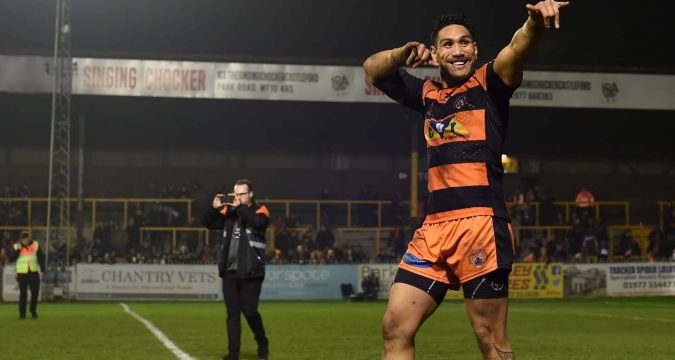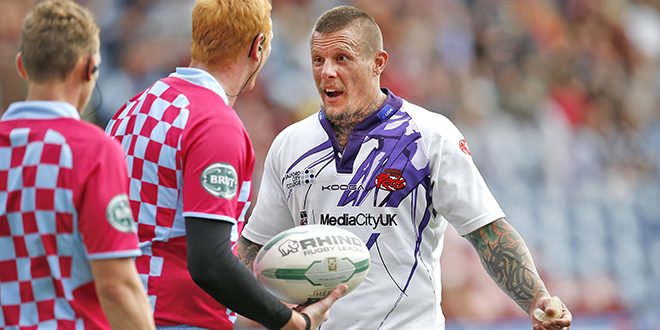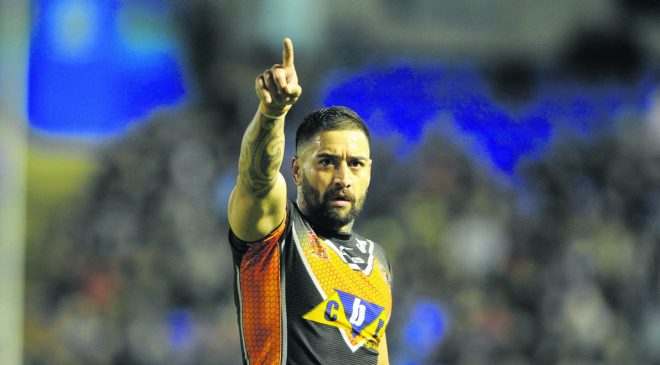
1. Jesse Sene-Lefao and Juniors Moors went to the same church.
When Jesse Sene-Lefao joined Castleford Tigers in 2017, there was a familiar face (and voice) in the ranks, that of Justin Moors. The two New Zealand-born forwards used to attend the same church in the Penrith area, where they had played their junior rugby. The two had played against each other numerous times during their younger years, going on to represent Samoa during separate occasions and have featured for the Tigers together in the past three seasons. Further links to Sene-Lefao in the Tigers camp, up until 2019, could be extended to former fullback Ben Roberts. Sene Lefao’s wife is Roberts’ cousin. Small world, right?
2. Ryan McGoldrick was dropped because of pole dancing and listed himself on eBay.

Where do we start? Former Castleford Tigers stalwart Ryan McGoldrick was dropped by the club in April 2011 for building a pole dancing facility for his teammates in his garden. The club had banned players from drinking in the town and the former Cronulla Sharks man decided to install a pole for dancers in his garden and invite members of the squad to drink in his garden instead. Add that to the fact he decided to go public about it in an interview with a newspaper and you have a recipe for a public apology. McGoldrick was certainly a maverick during his time at the club, known for driving through the town on his Harley-Davidson and for his heavily-tattooed body, the stories continued after retirement with Oxford in 2014. Two years after that, he posted a listing on eBay for his services in Rugby League, describing himself as a “1981 antique rugby league player.” eBay soon kicked the listing into touch, with the bidding as high as £215, as it “went against their policy of selling body parts.” It would seem that body parts got him dropped by Castleford and eBay… we went there.
3. The club stole one of their most famous slogans from British Gas.
It’s a good job this wasn’t Hugo Boss and 2020, because in the late 1960s they shamelessly stole a slogan from British Gas. The ‘High Speed Gas’ slogan was a great success for the business with a popular advert saying: “Come along to High Speed Gas, why not?” Blimey, looking back, there were real marketing linguists in the country back then. Nothing like giving your clientele a choice. Castleford were, like the new gas cookers, cooking up something special under then coach George Clinton, prompting fans to rather inventively continue the genius by swapping the ‘G’ for a ‘C’ to make ‘High Speed Cas.’ We’re all fortunate because, at the same time, the “Classy Cas” nickname was also beginning to emerge. One stuck. And Cas fans, boy did you get it right.
4. Brian Lockwood used to teach an Australia legend as a child.
In an interview for Rugby League magazine in 2017, a segment that was not used was a remarkable story from Castleford legend Brian Lockwood. The 1972 World Cup winner told of how, when he left the club briefly for Canterbury in the 1974 off-season, he taught a young boy how to play Rugby League. The young Canterbury local and fanatic supporter was, by Lockwood’s reckoning, one of the most talented young players to have picked up a ball. He regularly used to pester players to have a run-around and possessed an eager spirit. Lockwood and his teammates often obliged and found the participation fascinating for them, observing young genius at work. That was because it was a 13-year-old Brett Kenny. Lockwood explained how he wanted to learn everything. That, ladies and gentlemen, is how you become a Dally M player of the year, a Clive Churchill medallist (twice), Lance Todd Trophy winner and the recipient of the Golden Boot – not to mention a bona fide Rugby League legend on both Hemispheres. Be coached by Brian Lockwood.
5. Vowles and Chase really did stand out as Men of Steel.

It’s very easy to judge individual players’ abilities on the success of their team and the awarding of the Man of Steel award, in Super League, has certainly that supported that thesis. Of the 24 Men of Steel since 1996, 22 were presented the accolade the same year their side reached a major final or won the League Leaders’ Shield. The two that didn’t, as you can probably work out by now, were Castleford Tigers duo Adrian Vowles and Rangi Chase, in 1999 and 2011 respectively. In 1999, Castleford were eliminated in the Challenge Cup semi-finals to London Broncos, while their Grand Final hopes were dashed by St Helens at the same stage, after a fifth-place finish in the league. Similarly in 2011, the Tigers were pipped by Leeds Rhinos for a cup final berth, while they failed to even reach the play-offs with a ninth-place finish. The lowest league finish for any Super League Man of Steel. Chase’s enigmatic style was enough to see him win the award, paving the way for fellow Tigers Daryl Clark (2014) and Luke Gale (2017) to follow suit, as the club have had the most Men of Steel in the 2010s, with only Wigan boasting more than one.
